Light and delicate ricotta gnocchi are a lovely alternative to classic potato gnocchi and so easy to make. These fluffy Italian dumplings use just four ingredients—flour, cheese, egg, and salt. Serve this ricotta gnocchi recipe with a simple tomato sauce for a special night in.
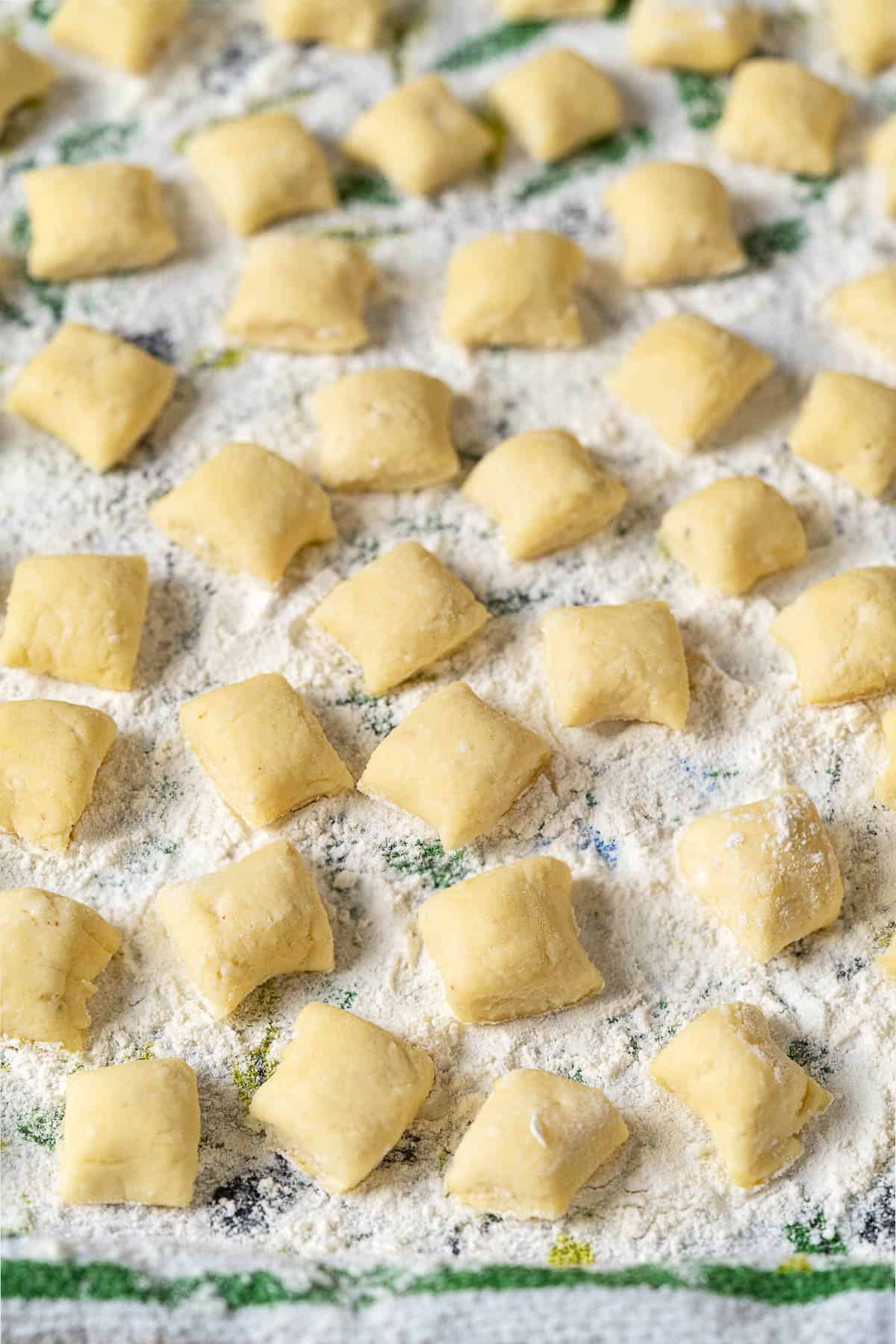
Ricotta gnocchi are small dumplings made by combining sweet, milky ricotta cheese with a little flour and egg. Regional Italian cooking has many types of gnocchi (pronounced “NYOH-key”). Variations include gnocchi made with cornmeal or semolina to breadcrumbs, potatoes, or ricotta.
Potato gnocchi are said to have originated in the southern Italian city of Sorrento. Ricotta gnocchi come from farther north, in Emilia-Romagna, the region that includes Bologna.
Ricotta gnocchi are traditionally served in spring during calving season, when fresh milk is in abundance and the production of ricotta cheese is at its highest. Today, pillowy ricotta gnocchi are enjoyed year-round, whether in restaurants or at home.
Anna Gosetti della Salda, a prominent food writer and editor in 20th-century Italy, first included a gnocchi recipe in her comprehensive book of regional recipes, Le Ricette Regionali Italiane, in 1967. Since then, ricotta gnocchi have only grown in popularity.
And thanks to the availability of good-quality fresh ricotta cheese you can make this ricotta gnocchi recipe at home even if you live far from Bologna.
Table of Contents
- Ingredients for Ricotta Gnocchi
- Ricotta Cheese: The Star Ingredient
- How to Pick the Best Ricotta Cheese
- Gnocchi Versus Gnudi: What’s the Difference?
- Tools for Homemade Ricotta Gnocchi
- How to Make Ricotta Gnocchi
- One Hour to One Day Before: Get Ready
- Make the Dough
- Roll the Gnocchi
- Shape and Dry the Gnocchi
- Cook, Store, or Serve the Gnocchi
- Troubleshooting Tips and Tricks
- How to Freeze Ricotta Gnocchi
- Best Sauces for Ricotta Gnocchi
- What to Serve with Ricotta Gnocchi
- More Italian Dinner Recipes
- Try our Nocellara-Italian Extra Virgin Olive Oil!
- Ricotta Gnocchi Recipe

Ingredients for Ricotta Gnocchi
Ricotta gnocchi takes just a few ingredients, most of which you probably have on hand. If not, they’re all easy to find at the store.
- Ricotta cheese: I use whole milk ricotta, which tastes fresh and has a pleasing rich texture. I avoid skim milk ricotta, as the flavor often tastes “off” to me and it has an unpleasantly grainy texture.
- Parmigiano cheese: Freshly grated Parmigiano-Reggiano cheese adds a savory note to the flavor of ricotta gnocchi.
- Egg: A single egg helps to bind the ricotta and enrich the dough.
- Salt: A dash (about 1/4 teaspoon) rounds out the flavor of the gnocchi.
- Nutmeg: Although optional, I almost always add a fresh grating of nutmeg to gnocchi dough. I love its warming perfume and slightly sweet flavor. Just a touch is all you need.
- Unbleached all-purpose flour: You’ll need about 1 cup, or slightly more, to transform the ricotta into dough.
- Semolina flour: This is optional–you can use all-purpose flour–but I like to use semolina flour to dust the surface where I place the gnocchi after shaping them. It’s less readily absorbed than all-purpose flour so it helps to prevent sticking.
- Sauce: Have a batch of your favorite sauce ready to go so you can toss it with your cooked gnocchi. See “Best Sauces for Ricotta Gnocchi” below for my recommendations.
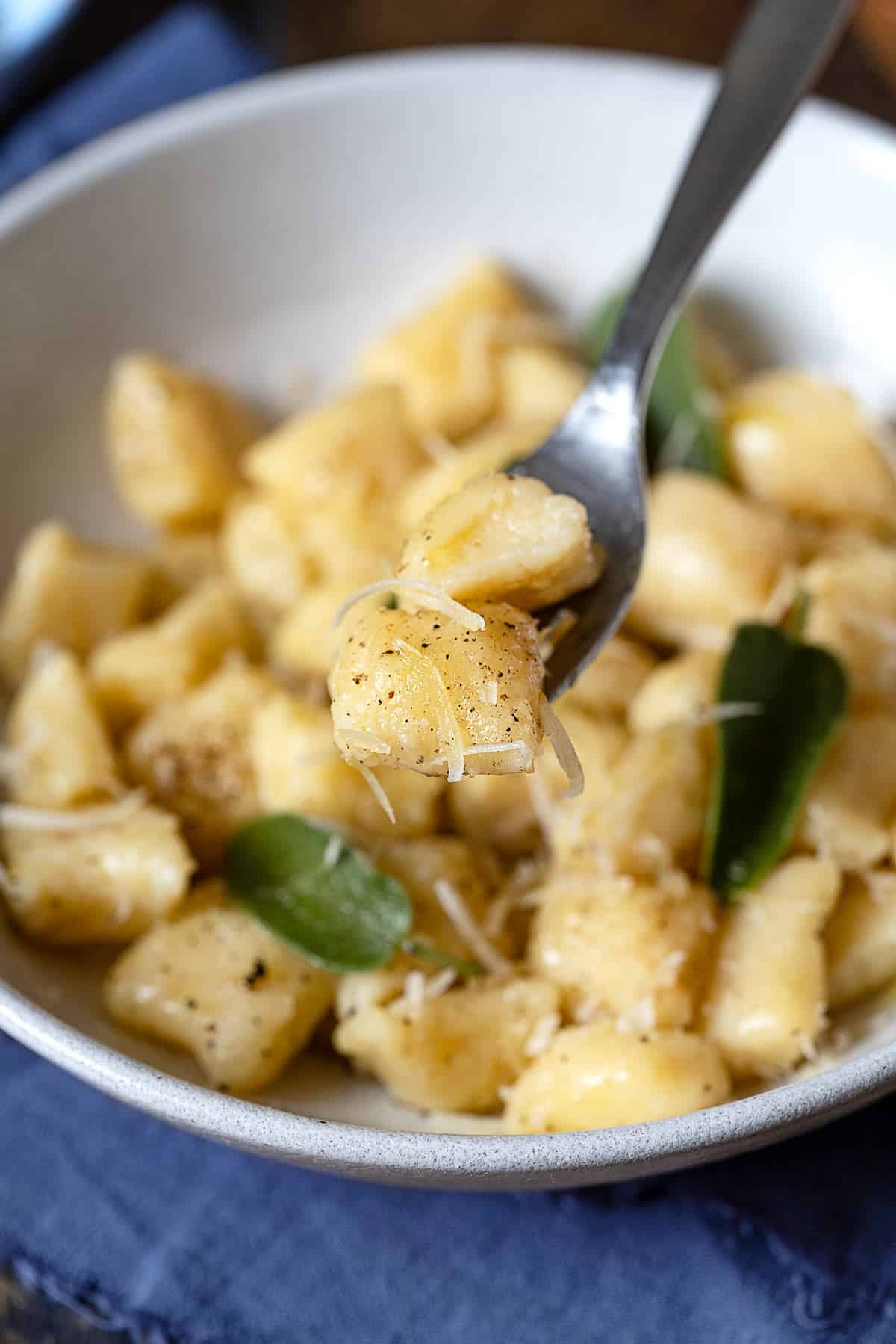
Ricotta Cheese: The Star Ingredient
Ricotta is actually a byproduct of cheese production. It is made by reheating the whey that’s leftover from the making of other cheeses like mozzarella. Hence the name “ricotta,” which translates to “cooked again.”
The curds that form during the reheating process are collected and drained in baskets. You can make ricotta from sheep, goat, or even buffalo milk, but cow’s milk ricotta is the most common.
Italian cooks and bakers rely on this fresh, milky curd cheese for many traditional and iconic dishes. It’s used in everything from savory lasagna and ravioli to the famed pastries like sfogliatelle and cannoli.
Ricotta has a gentle, faintly sweet flavor and rich, creamy texture with slight roughness from the curds. Depending on how long it drains, it can either be spooned or sliced. It’s typically sold in plastic tubs, but you can also find it packed into metal containers with drainage holes at the bottom, with the container shrink-wrapped in plastic to prevent leakage.
How to Pick the Best Ricotta Cheese
Whether I’m cooking or baking, I use whole milk ricotta for its fresh flavor and rich texture. Look for whole milk ricotta that is either locally produced or from a brand whose product you know and trust. Make sure the ricotta you are buying is fresh. Always check the container for a sell-by or use-by date. The freshness and quality of ricotta will be reflected in the gnocchi you make.
You’ll also need to thoroughly drain the ricotta before making gnocchi. Wet ricotta makes gummy gnocchi, definitely not what you’re aiming for.

Gnocchi Versus Gnudi: What’s the Difference?
While both ricotta gnocchi and gnudi are dumplings made with ricotta cheese, gnudi are made with a minimal amount of flour. They’re larger and fluffier than ricotta gnocchi. And, ricotta gnocchi are a bit more substantial in texture. They resemble potato gnocchi in both size and shape, but with a delicate milky flavor and lighter body.
Tools for Homemade Ricotta Gnocchi
These tools will make forming and shaping gnocchi easier, but ricotta is a very humble dish at its core. You really don’t need fancy kitchen equipment or tools. I provided more common household alternatives for each:
- Cheesecloth or paper towels: To make great ricotta gnocchi, you must drain the ricotta. Cheesecloth is the best material for draining extra whey from ricotta without the cheese itself seeping out. If you don’t have cheesecloth, use several layers of paper towels.
- Bench scraper or knife: I use a bench scraper to help incorporate the flour into the ricotta without overhandling the dough. It also comes in handy for cutting the rolled out ropes of gnocchi dough into bite-sized pieces. You can use a wooden spoon, your hands, and a knife if you don’t have a bench scraper.
- Gnocchi board or table fork: I love my rigagnocchi, a small wooden board with a handle and a ridged surface for rolling gnocchi. When you roll the little nuggets of dough down the board with your thumb, it creates beautiful, even ridges on one side and a depression from your thumb on the other. The purpose for this shaping is two-fold. First, the depression helps the gnocchi to cook evenly. Second, both the depression and the ridges help “capture” sauce, making your gnocchi even more delicious. Gnocchi boards are inexpensive and can be found online. However, you can just as easily use a fork. Roll the nuggets of gnocchi down the inside of the fork to create ridges on one side and a depression on the other. Or if just leave the gnocchi without any ridges as I do in this recipe.
- Large, rimmed baking sheet or your countertop: One or two large (12 x 17-inch) rimmed baking sheets nearby hold your gnocchi as you shape them. Line the sheet with a clean kitchen towel, and dust the towel generously with semolina flour or all-purpose flour to prevent sticking. If your kitchen table is free, you can cover it with a clean tablecloth and dust it with flour instead.

How to Make Ricotta Gnocchi
Making homemade ricotta gnocchi is a relatively quick and very satisfying process–it’s easier than potato gnocchi, which is easier than homemade pasta. This recipe makes 100 to 120 gnocchi, which is enough to serve 4. You can easily double the recipe for more servings.
One Hour to One Day Before: Get Ready
- Drain the ricotta. This is a good step to do ahead of time, even the day before you plan to make gnocchi. Set a colander in a bowl or plate and line it with cheesecloth or several layers of paper towels. Spoon about 1 1/4 cups of ricotta into the cheesecloth and twist the ends over the ricotta to enclose the cheese completely. Place a small plate on top of the cheese and weigh it down with a heavy object. I use a small mortar, but any heavy object like a pot or large canned food will do. Set in your fridge to drain for at least one hour, until it is no longer loose or watery. You should end up with 1 cup of dense, well-drained ricotta.
Make the Dough
- Mix the ingredients. Place the ricotta in a large mixing bowl and add 1/4 cup of grated Parmigiano. Lightly beat one large egg and add it to the bowl. Add a pinch of salt and a pinch of freshly grated nutmeg, if using. Fold everything together with a sturdy spatula.
- Incorporate the flour. Sprinkle about 2/3 cup of flour over the top of the mixture and fold it just until it’s incorporated. It should be quite stiff. Use a little more of the flour to flour your work surface. Scrape the mixture onto the surface and sprinkle a little more flour on top. Briefly knead and pat the dough into a ball, adding flour bit by bit as needed, but not too much. The dough should feel pliable and not completely smooth. It should be slightly damp but not sticky.
Roll the Gnocchi
- Get ready to roll. Line a baking sheet with a clean kitchen towel. Sprinkle a generous coating of semolina flour or all-purpose flour on the towel. This is where you will put your gnocchi as you cut them.
- Roll out the dough. Cut the dough into 4 equal pieces. Remove one piece and cover the rest with a clean kitchen towel or a bowl. Sprinkle the work surface with a little flour. Don’t add too much flour, or you will not get the traction necessary to roll out the ropes. Roll the piece of dough into a rope about the thickness of your finger. Easy does it—try not to put too much pressure on the dough. Set the rope aside and roll the remaining 3 pieces of dough into ropes.
- Cut the ropes of dough into pieces. Line the ropes up into 4 rows and sprinkle a little flour over the top. Use a bench scraper or chef’s knife to cut the ropes into 3/4-inch nuggets. If the pieces of dough are sticky, sprinkle a little more flour on top and toss them gently to coat them with the flour. You should end up with 100 to 120 gnocchi.
Shape and Dry the Gnocchi
- Shape the gnocchi (optional). If you prefer, you can leave the nuggets as is shown in the photos. Simply transfer them to the prepared baking sheet to rest. However, I prefer to do this shaping step because, in my opinion, it makes better gnocchi. Roll each piece of dough, one at a time, down the floured tines of a fork or a gnocchi board, using your thumb to propel it downward, creating a small indentation. When you are done, you should have the groove from your finger on one side and ridges from the fork tines or gnocchi board on the other. The ridges and groove help the gnocchi to cook evenly in boiling water, and they are great for “capturing” sauce. Place the gnocchi on the baking sheets as you roll them. To see how this process is done watch the video for my gnocchi alla sorrentina recipe.
- Dry the gnocchi. If you plan to cook the gnocchi within a couple of hours, you can leave them on the baking sheet. Let the gnocchi “dry” for about 30 minutes, then cover them lightly with a kitchen towel. This brief “drying” period will not make the gnocchi hard or firm; it’s mainly to prevent them from clumping together. Otherwise, see “how to freeze ricotta gnocchi” below for longer storage.
Cook, Store, or Serve the Gnocchi
- Get ready to cook the gnocchi. Bring a large pot of water to a rolling boil and salt it generously. Have a batch of heated sauce at the ready—I like lamb or mushroom ragù, simple tomato sauce, or browned butter or olive oil-sage sauce.
- Cook the gnocchi. Spoon a little of the sauce into a serving bowl. When the water is at a full boil, gently drop in the gnocchi. Add in batches to avoid crowding the pot. In a couple of minutes, even before the water returns to a boil, the gnocchi will start to bob to the surface. Let them cook for about 2 minutes, then taste one. It should be soft and tender but cooked throughout, with no raw flour flavor. If it’s not quite done, let it cook another minute or so, then taste again.
- Dress and serve the gnocchi. Transfer the cooked gnocchi with a skimmer or slotted spoon to the warmed serving bowl and spoon more sauce on top. Toss very gently to coat all the gnocchi. Sprinkle with a little Parmigiano on top and serve.
Troubleshooting Tips and Tricks
If you’re new to making ricotta gnocchi, here are a few tips to help you navigate the process. Once you’ve tried it, you’ll realize how fun and satisfying it is to make homemade gnocchi!
- Really drain your ricotta. Ricotta holds a lot of moisture. This is the whey from which the ricotta curds are formed. Not draining the ricotta properly will result in sticky dough that requires extra flour, which will make the gnocchi gummy. It should be thick and dense and almost sliceable when properly drained.
- Mix the ingredients without flour. Before you add flour to your gnocchi dough, thoroughly combine all the other ingredients: ricotta, Parmigiano, egg, salt, and nutmeg. Add flour only after you have a uniform mixture.
- Go easy on the flour. As with potato gnocchi, too much flour can make ricotta gnocchi dense, gummy, and tough. Start by incorporating 2/3 of the flour and add more as needed. Add just enough for the dough to form a compact ball. It should stay together and is slightly tacky but not sticky. Always use a light hand when mixing gnocchi ingredients. No heavy kneading here!
- Test the gnocchi. Ricotta gnocchi aren’t prone to falling apart the way potato gnocchi can be. But, if you want to be sure, roll out a few and cook them in a pot of boiling water. The gnocchi should be light but not insubstantial.
How to Freeze Ricotta Gnocchi
One great quality about ricotta gnocchi is that they keep well in the freezer. They’re a good make-ahead project. If you’re planning a dinner party, you can make the gnocchi a week or two in advance and freeze them. Then, when it’s serving time, all you have to do is cook them.
To freeze gnocchi, let them dry for about 30 minutes after shaping. Then, place the baking sheet in the freezer and let the gnocchi freeze until hard, about 2 hours. Once they are hard, transfer them to a zipper-lock freezer bag or a tightly lidded container and return them to the freezer.
To cook frozen ricotta gnocchi, transfer them directly from the freezer to a pot of boiling salted water. Frozen gnocchi may take a minute or two longer than fresh gnocchi to fully cook. They should bob to the surface of the water and fluff up a bit. Taste one to be sure there is no raw flour taste.

Best Sauces for Ricotta Gnocchi
The delicate flavor of ricotta gnocchi pairs well with a great variety of sauces. In her book Le Ricette Regionali Italiane, author Anna Gosetti della Salda suggests dressing ricotta gnocchi with meat sauce. Or, simply with melted butter and Parmigiano cheese. I love both these options, depending on what I’m in the mood for. Here are some other favorite sauces for ricotta gnocchi:
- Simple Tomato Sauce: My go-to tomato sauce has just a few ingredients—tomato passata (purée), extra-virgin olive oil, garlic, salt, and fresh basil. It’s the same sauce I use to make Gnocchi alla Sorrentina, which is a dish of baked potato gnocchi with tomato sauce and mozzarella. In fact, you can substitute homemade ricotta gnocchi for potato gnocchi to make Gnocchi alla Sorrentina, with delicious results! Our Easy Homemade Spaghetti Sauce recipe is also a delicious, light tomato sauce to serve with creamy ricotta gnocchi.
- Lamb ragù: In spring, I like to serve ricotta gnocchi with lamb or mushroom ragù for a Sunday dinner treat. Or, for another spring option, substitute ricotta gnocchi for pasta in this recipe for Pancetta Pasta with Peas and Parmesan.
- Olive Oil, Salt, Pepper and Parmesan: Think of this as cacio e pepe only with gnocchi. Cook the gnocchi according to this recipe, then warm 2 tablespoons of good olive oil in a medium skillet set over medium heat. Add the gnocchi to the pan, and sear on both sides (or keep the heat low if you don’t like to sear the gnocchi). Remove from the skillet (oil and all) season with a freshly cracked black pepper, salt, and shaved Parmesan cheese. Drizzle with a little more olive oil and serve.
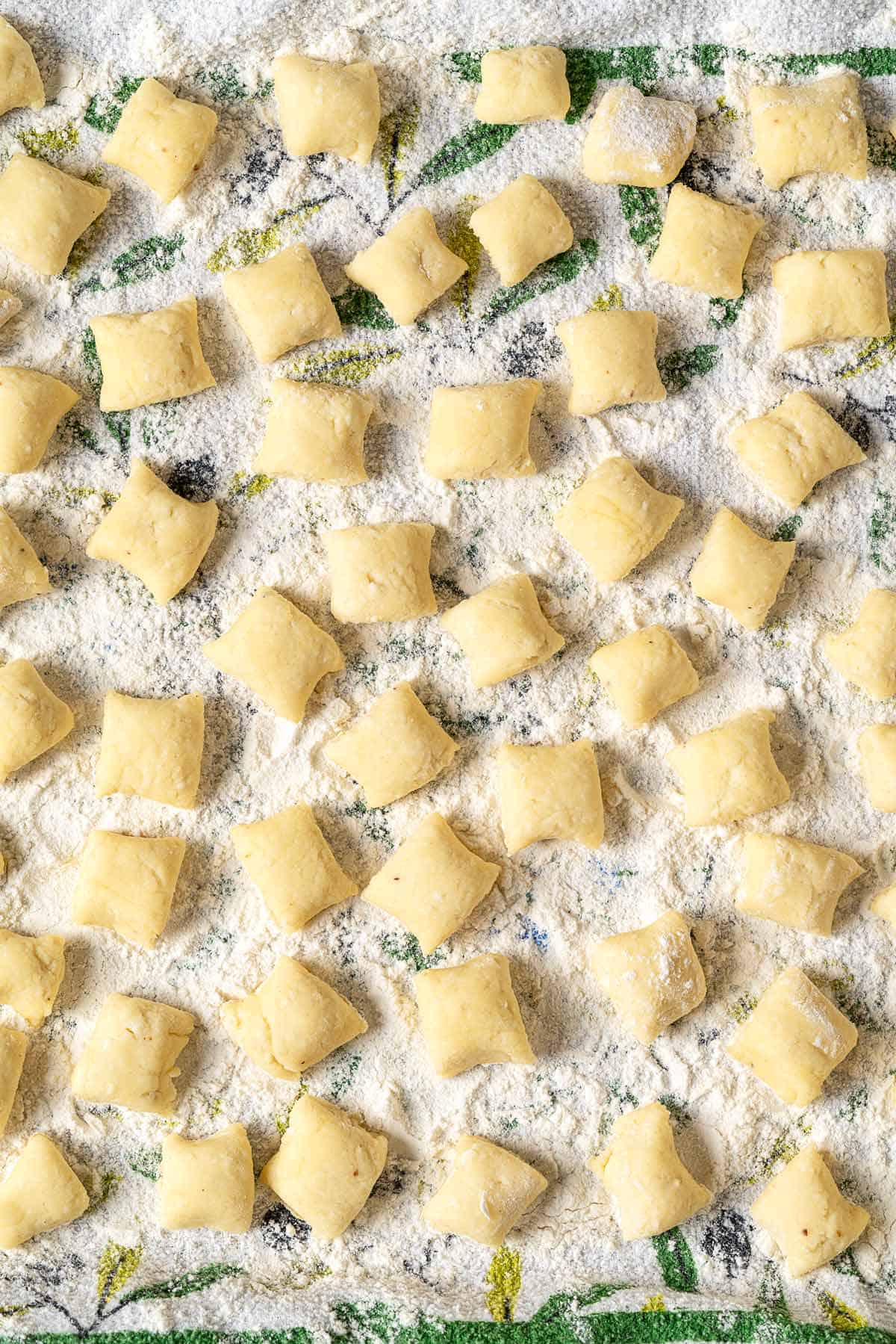
What to Serve with Ricotta Gnocchi
Make this ricotta gnocchi recipe as as a main dish or as a first course—primo piatto in Italian.
Serve the tender gnocchi either before or after a hearty salad, like Roasted Asparagus Salad. Or, serve as a main course with a colorful and nutritious side dish, like Italian Roasted Vegetables or Mediterranean Roasted Artichokes.
More Italian Dinner Recipes
Browse all Mediterranean recipes.
Visit Our Shop
Try our Nocellara-Italian Extra Virgin Olive Oil!
This EVOO is produced from hand-picked, cold-extracted Nocellara olives. High in polyphenols with aromas of fresh tomatoes and vegetables with a mildly bitter and spicy finish.

Ricotta Gnocchi
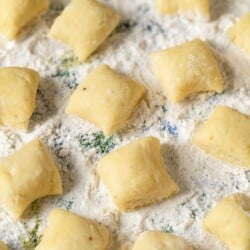
Ingredients
- Semolina flour, for dusting (or use all purpose)
- 1 cup plus 2 tablespoons unbleached all-purpose flour, plus more as needed
- 1 1/4 cup whole milk milk ricotta
- 1/4 cup freshly grated Parmigiano-Reggiano cheese, plus more for serving
- 1 large egg, lightly beaten
- 1/4 teaspoon fine salt
- Pinch of freshly grated nutmeg (optional)
- Pasta sauce, like ragu, simple tomato sauce, or pesto, for serving
Instructions
- Drain the ricotta. This is a good step to do ahead of time, even the day before you plan to make gnocchi. Set a colander in a bowl or plate and line it with cheesecloth or several layers of paper towels. Spoon the ricotta into the cheesecloth and twist the ends over the ricotta to enclose the cheese completely. Place a small plate on top of the cheese and weigh it down with a heavy object. I use a small mortar, but any heavy object like a pot or large canned food will do. Let the ricotta drain for at least an hour, until it is no longer loose or watery. You should end up with 1 cup of dense, well-drained ricotta.
- Make the gnocchi dough. Cover a large, rimmed baking sheet with a clean kitchen towel and dust generously with flour. In a large mixing bowl, combine 1 packed cup of the drained ricotta, Parmigiano, eggs, salt, pepper, and nutmeg, if using. Mix well. Sprinkle about 2/3 cup of the flour over the top and fold it in until it’s quite stiff. Dust your work surface with all purpose flour. Scrape the mixture onto a lightly floured surface and sprinkle a little more flour on top. Knead the dough into a pliable ball, adding flour bit by bit as needed, but not too much. The dough should feel slightly damp but not sticky.
- Roll into ropes. Cut the dough into 4 equal pieces. Remove one piece and cover the rest with a clean kitchen towel. Sprinkle the work surface with a little more flour and roll the piece of dough into a rope about the thickness of a finger. Roll the remaining pieces of dough into ropes. Then cut the ropes crosswise into 3/4-inch pieces. Toss the pieces lightly in flour to prevent them from sticking or clumping together.
- Ridge the gnocchi (optional). Roll each piece of dough down the tines of a floured fork or gnocchi board, using your thumb to propel it, creating a small indentation. When you are done, you should have the groove from your finger on one side and ridges from the fork tines or gnocchi board on the other. Place the gnocchi on the baking sheets as you roll them. You should end up with about 120 gnocchi.
- Rest the gnocchi. Let the gnocchi rest for 30 minutes, uncovered. Then, cover with a clean kitchen towel and cook within 2 hours. (See notes for freezing tips.) This is a good time to ready your pasta sauce!
- Get ready to cook the gnocchi. Bring a large pot of water to a rolling boil and salt it generously. Have a batch of heated sauce at the ready.
- Cook the gnocchi. When the water is at a full boil, gently drop in the gnocchi. Cook in batches if necessary to avoid crowding the pot. In a couple of minutes, even before the water returns to a boil, the gnocchi will start to bob to the surface. Let them cook for about 2 minutes, then taste one; it should be soft and tender but cooked throughout, with no raw flour flavor. If it’s not quite done, let it cook another 1 or 2 minutes, then taste again.
- Serve. Ladle the warm pasta sauce into your serving bowls. Transfer the cooked gnocchi with a skimmer or slotted spoon to the serving bowl and spoon more sauce on top. Toss very gently to coat all the gnocchi. Sprinkle a little Parmigiano on top and serve.
Video
Notes
- To freeze, pop the baking sheet in the freezer after the gnocchi have rested for 30 minutes. Freeze until the gnocchi are solid, about 2 hours, then transfer to a zipper-lock freezer bag or a tightly lidded container. Freeze for up to one month. There’s no need to thaw frozen gnocchi. Simply boil until they’re cooked through, which takes a couple extra minutes.
- Gnocchi cools quickly. If you have the time, preheat your serving bowls in your oven on the lowest setting. Spoon the sauce into the preheated bowls, and return to the oven to keep warm until you’re ready to (carefully) add the gnocchi.
- Visit our shop to browse quality Mediterranean ingredients including olive oils, honey, jams and spices.


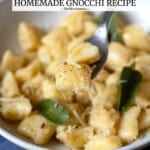
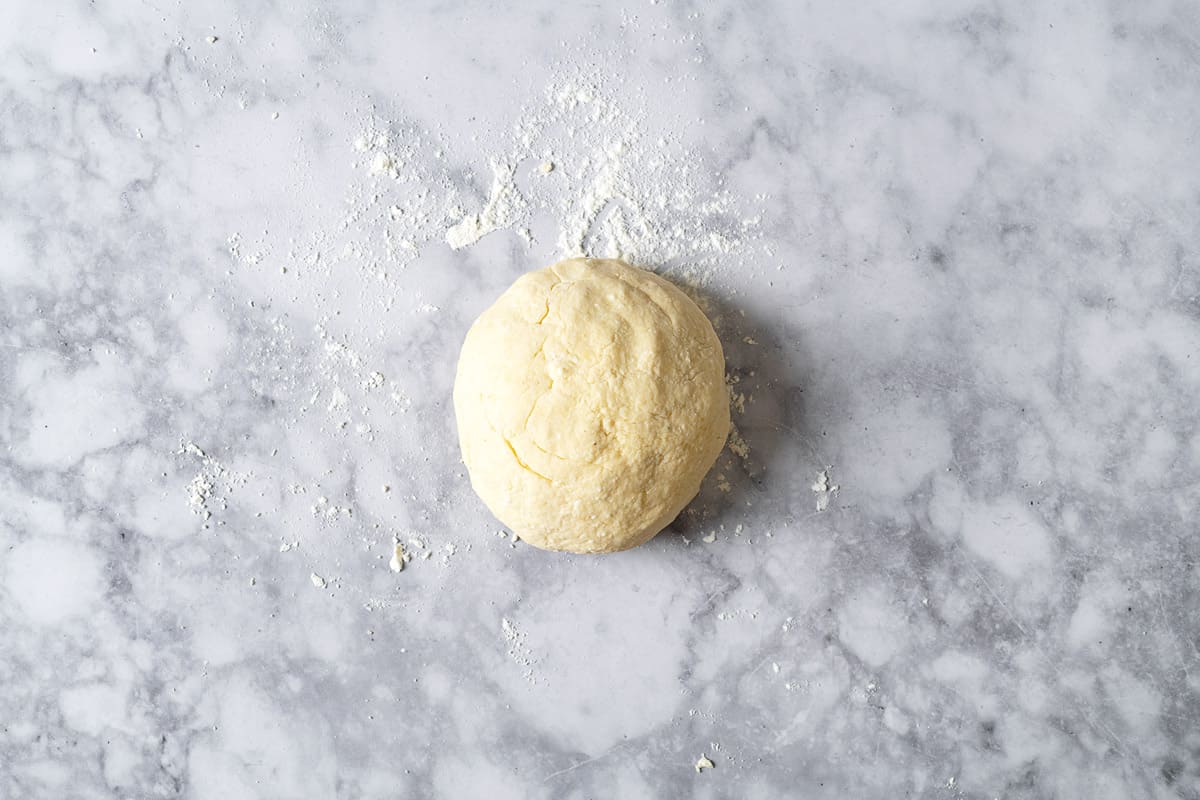
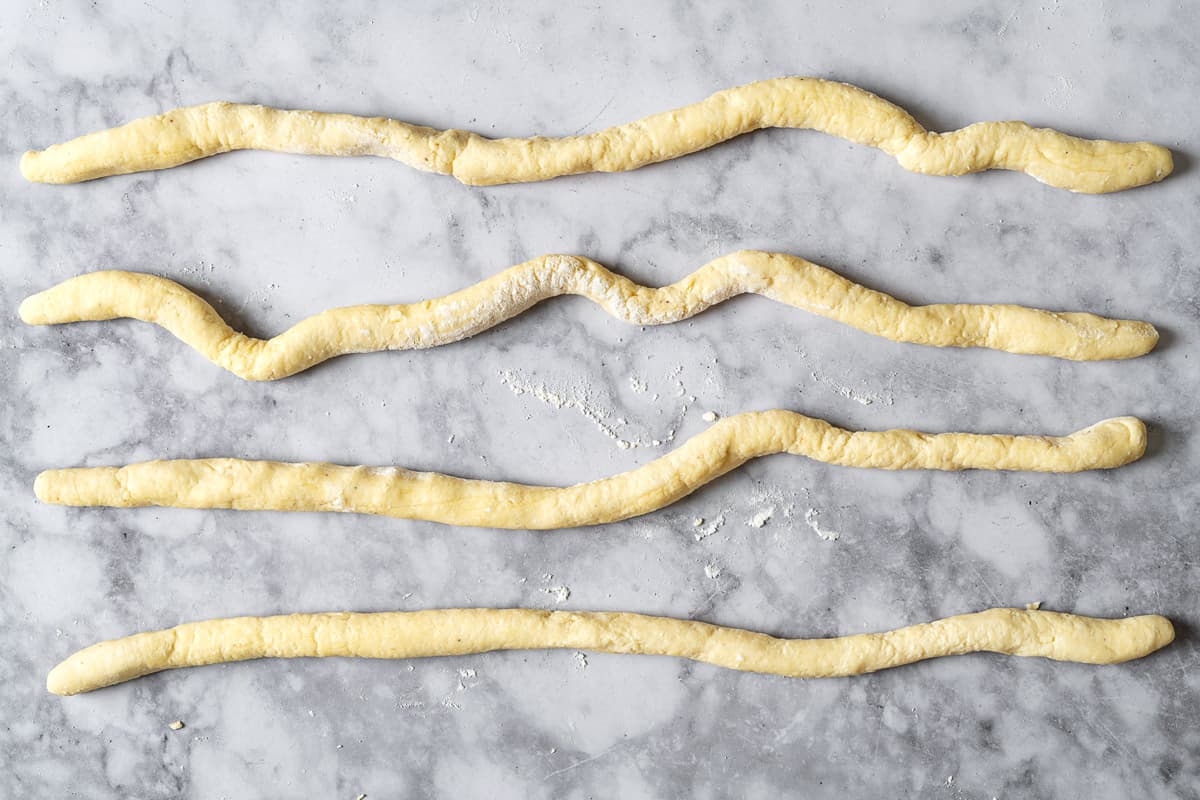

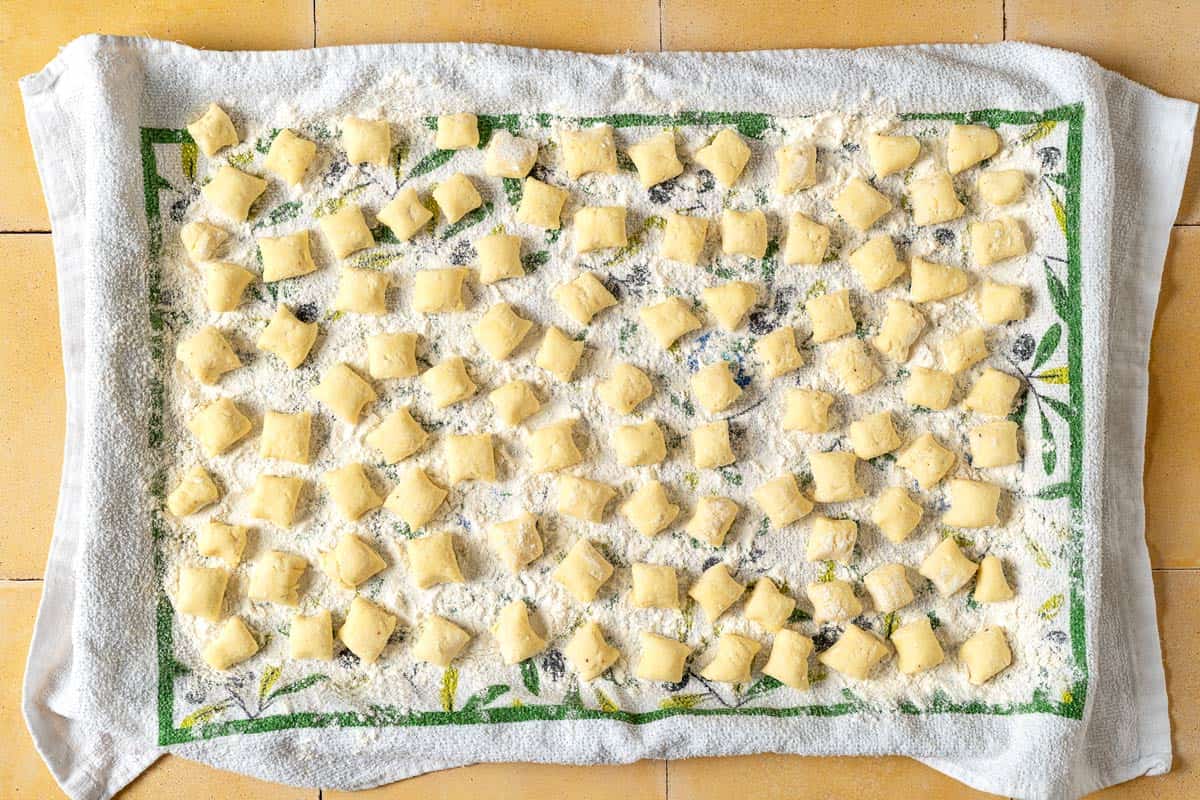






Great recipe
Thanks, Victoria!